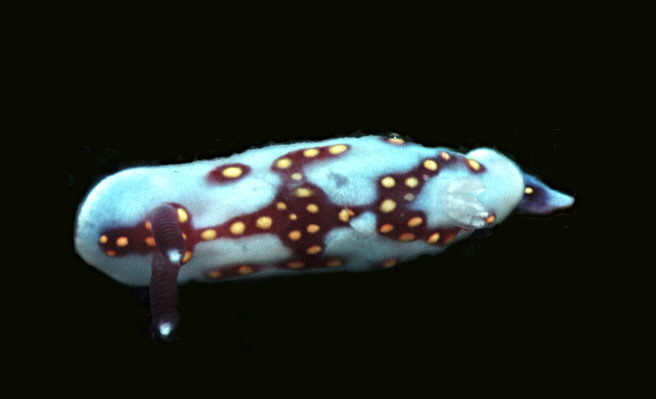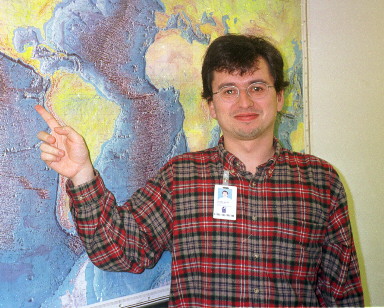
| Chromodoris ruzafai Photo courtesy of Terry Gosliner |
Chromodoris ruzafai, Ortea, Bacallado and Valdes, 1992
At first look, specimens of Chromodoris ruzafai appear to be juveniles of the common West American species Chromodoris sphoni (Marcus, 1971). However, a careful examination will show that the color pattern is a little unusual. The rhinophores are not white with a red and black apex, but red with a white apex. Also, the gill is entirely white, with some pink in the edges, not white with the apex red and black as in C. sphoni. In addition, the yellow spots on the dorsum appear to be larger, and there is not the typical pale blue band around the mantle margin of C. sphoni. If one specimen is dissected, then we will become aware that this is actually a different species, having several anatomical differences with C. sphoni.
The color resemblance between both species is surprising, but this is not an exception among the chromodorid nudibranchs. Rudman was the first author introducing the concept of color groups (several species sharing a similar color pattern) in nudibranch systematics. In fact, he divided his review of the Indo-Pacific Chromodoridae into several papers, each of them dealing with a different color group, rather than different taxonomic groups. Rudman named each color group with the name of the most common of its species. Examples are the Chromodoris quadricolor, Chromodoris splendida, Noumea purpurea and Chromodoris epicuria color groups. In the Atlantic Ocean, several color groups have been recognized by Ortea: blue Hypselodoris, Chromodoris clenchi and Chromodoris luteorosea color groups. The origin and ecological implications of the color groups in nudibranchs are still poorly understood. Any color group has been already introduced to include C. sphoni and C. ruzafai. Another chromodorid with a similar coloration known from the West Pacific coast is Hypselodoris agassizii.
C. ruzafai is not a common species, and at present has only been collected from the Galapagos Islands. Therefore, provisionally has to be considered as endemic to these islands. Very little is known about the biology of C. ruzafai. Animals are usually collected in tide pools or deeper, but always in shallow waters. The spawn of one specimen was found in March. The eggs are very densely packed and they have an average diameter of about 123 Ám. The feeding preferences of this species are unknown.
The specimens studied in the original description were collected during the two scientific expeditions of the Museo de Ciencias Naturales de Tenerife (Spain) to this archipelago, in Isabela and Santiago Islands. The species is named after Angel Prez Ruzafa, a Spanish marine biologist who assisted in the collection of the material.
Taxomonic data courtesy of Angel Valdes

Send Angel mail at avaldes@casmail.calacademy.org
|
